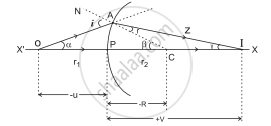Advertisements
Advertisements
Question
Answer the following question.
A spherical surface separates two transparent media. Derive an expression that relates object and image distances with the radius of curvature for a point object. Clearly state the assumptions, if any.
Solution
- Consider a spherical surface YPY′ of radius curvature R, separating two transparent media of refractive indices n1 and n2 respectively with n1 < n2.
- P is the pole and X′PX is the principal axis. A point object O is at a distance u from the pole, in the medium of refractive index n1.
- In order to minimize spherical aberration, we consider two paraxial rays.
- The ray OP along the principal axis travels undeviated along with PX. Another ray OA strikes the surface at A.

Refraction at a single refracting surface - As n1< n2, the ray deviates towards the normal (CAN), travels along with AZ, and a real image of point object O is formed at I.
- Let α, β and ϒ be the angles subtended by incident ray, normal and refracted ray with the principal axis.
∴ i = (α + β) and r = (β − γ) - As the rays are paraxial, all the angles can be considered to be very small.,
i.e., sin i ≈ i and sin r ≈ r
Angles α, β, and ϒ can also be expressed as,
α = `"arcPA"/"OP"="arcPA"/-"u"`,
β = `"arcPA"/"PC"="arcPA"/"R"`
and γ = `"arcPA"/"PI"="arcPA"/"v"` - According to Snell’s law,
n1 sin (i) = n2 sin (r)
For small angles, Snell’s law can be written as, n1i = n2r
∴ n1 (α + β) = n2 (β − ϒ)
(n2 − n1) β = n1α + n2γ
Substituting values of α, β and ϒ, we get,
(n2 − n1) `"arcPA"/"R"="n"_1("arcPA"/-"u")+"n"_2("arcPA"/"v")`
∴ `("n"_2-"n"_1)/"R"="n"_2/"v"-"n"_1/"u"`
Assumptions:
To derive an expression that relates object and image distances with the radius of curvature for a point object, the two rays considered are assumed to be paraxial thus making the angles subtended by incident ray, normal and refracted ray with the principal axis very small.
APPEARS IN
RELATED QUESTIONS
Choose the correct option.
A student uses spectacles of number -2 for seeing distant objects. Commonly used lenses for her/his spectacles are
Consider the following statements regarding a simple microscope
(P) It allows us to keep the object within the least distance of distant vision.
(Q) Image appears to be biggest if the object is at the focus.
(R) It is simply a convex lens.
Answer the following question.
Derive lens makers’ equation. Why is it called so? Under which conditions focal length f and radii of curvature R are numerically equal for a lens?
Solve Numerical example.
A convex lens held some distance above a 6 cm long pencil produces its image of SOME size. On shifting the lens by a distance equal to its focal length, it again produces the image of the SAME size as earlier. Determine the image size.
A point object is kept 10 cm away from one of the surfaces of a thick double convex lens of refractive index 1.5 and radii of curvature 10 cm and 8 cm. Central thickness of the lens is 2 cm. Determine location of the final image considering paraxial rays only.
Solve Numerical example.
A person uses spectacles of ‘number’ 2.00 for reading. Determine the range of magnifying power (angular magnification) possible. It is a concavoconvex lens (n = 10.5) having a curvature of one of its surfaces to be 10 cm. Estimate that of the other.
Solve Numerical example.
Focal power of the eye lens of a compound microscope is 6 dioptre. The microscope is to be used for maximum magnifying power (angular magnification) of at least 12.5. The packing instructions demand that length of the microscope should be 25 cm. Determine minimum focal power of the objective. How much will its radius of curvature be if it is a biconvex lens of n = 1.5?
